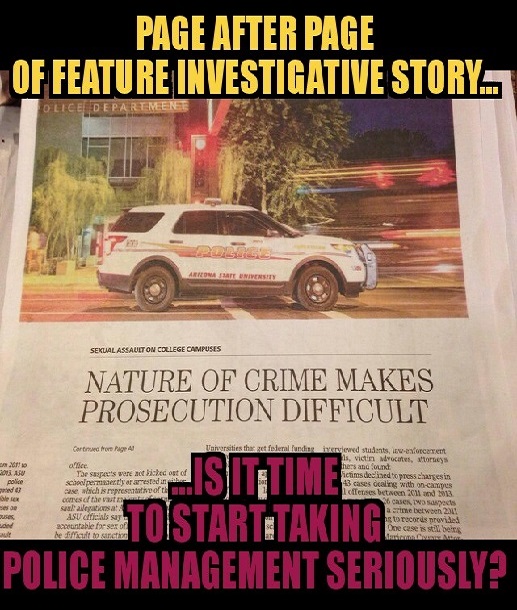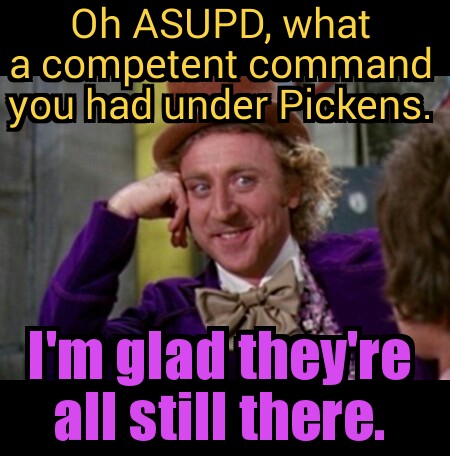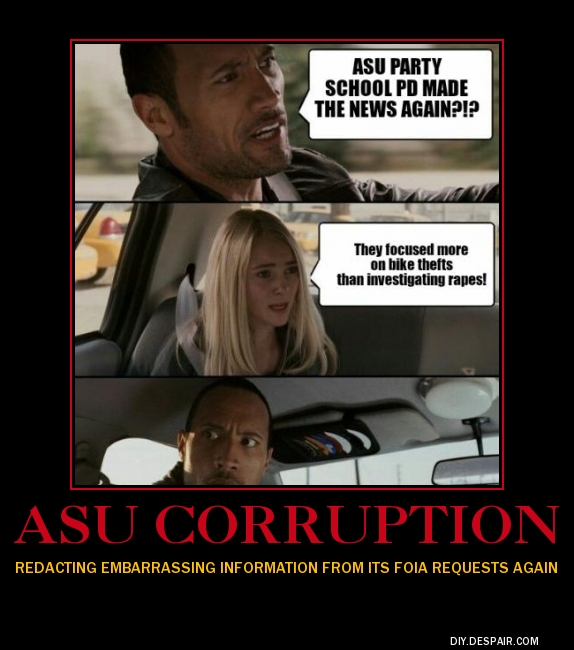
On Sunday, November 23rd, The Arizona Republic’s investigative journalist Anne Ryman exposed Arizona State University’s sexual assault problem; namely, how sexual assaults that occur at on campus are less likely to result in an arrest/conviction versus the same type of incident occurring off campus. The article also focuses on processes external to the criminal case–namely filing a complaint with the Office of Student Rights and Responsibilities, Title IX requirements–as well as personal stories from two sexual assault survivors.
Due to the vast amount of information discussed in Ms. Ryman’s article, we will be narrowing the scope of this post to explore factors that contribute to ASUPD’s disproportionately low sexual assault case clearance and conviction rate. According to the article:
From 2011 to 2013, ASU police investigated 43 forcible sex offenses, a category which includes sexual assault and sexual abuse, with two cases ending in convictions, according to police. A 2012 case is still under review for possible charges by the Maricopa County Attorney’s Office.
Police said victims declined to prosecute in 17 of the cases and nine cases submitted to the county were turned down or did not proceed based on “no likelihood of conviction.”
Nationally, among the public at large, one-fifth of sexual assaults reported to police result in prosecution, according to the U.S. Department of Justice (DoJ). Of those who are prosecuted, about half are convicted of felonies.
Using the average case clearance rates provided by the DoJ, approximately 9 out of the 43 forcible sex offenses reported to ASUPD should result in conviction; however ASUPD had only two cases ending in conviction, with one more under review by the county attorney. Even if the 17 cases where the victim’s declined to aid in prosecution are thrown out of the equation, ASUPD’s case prosecution rates still fell below the DoJ averages. Compare ASUPD’s case clearance and conviction rate to that of the Tempe Police Department:
In 2013, Tempe police identified 13 cases that involved ASU students assaulted off campus and made arrests in three of those cases, documents say.
Tempe PD’s case clearance rates are consistent with the aforementioned DoJ prosecution rates of sexual assaults.
Why is there a significant discrepancy between the rates of arrest/prosecution of ASUPD’s sex assault cases compared to Tempe PD’s cases?
- Failures in department leadership:
- Department leadership may not view sex crimes as a serious problem compared to other types of crime, and may divert resources to other areas they view as more important (ASUPD emphasizes steps to avoid bike theft, as well as diverting department resources, such as personnel, to curtail the problem). Undoubtedly a major contributing factor under the Pickens-era leadership.
- Negligent supervision:
- Officers/detectives who are not properly supervised may not receive the on-the spot feedback needed to prevent similiar mistakes from happening in the future.
- If a supervisor does not take interest in investigating a sex crime thoroughly, it shows subordinate employees that sex crimes are not important.
- Employees may feel entitled/empowered to do whatever they want, because they are lacking adequate supervision.
- This may or may not explain Sergeant T. Lewis’ abrupt removal from CIB under Chief Thompson.
- Poor training:
- Officers should receive additional sexual assault first responder training; most officers don’t receive additional training outside of the academy.
- Officers should understand and be able to properly collect and impound physical evidence–while thoroughly adhering to procedures pertaining to chain of custody–so it may be preserved for future lab testing.
- Detectives should receive ongoing, specialized training in interview techniques, evidence collection and preservation, as well as familiarity with laws pertaining to sex crimes.
- Due to the frequency of sex related crimes on campus, sex crimes should comprise the “bread and butter” of investigations!
- According to police reports released to The Arizona Republic, ASUPD only utilized a confrontation call ONCE in a three year time frame.
- “Guilty until proven innocent” mindset of some detectives, characterized by: an emphasis that stranger rape is the only real rape; a belief that nonstranger sexual assault is not as serious as stranger rape and is often the victim‘s fault; statements that any victim inconsistency ruins her credibility; an emphasis on the ubiquity of false reporting and victims‘ lack of cooperation (cited from a 2012 DoJ research study).
- Detectives have to WANT to work sex crimes cases, or they are at risk for developing the “guilty until proven innocent” approach.
- Research revealed that often the cases that are presented to the County Attorney before an arrest is made are cases that have not been thoroughly investigated by law enforcement and are presented to the County Attorney in anticipation of a “reject”.
- Half-assed criminal investigations are given to the County Attorney knowing they will be turned down
- Whether a suspect is arrested should NOT be contingent on whether the prosecuting attorney believes that the case would result in a jury conviction
Why did Arizona State University fail to release 19 sex assault reports to The Arizona Republic?
We’ve identified some possible reasons that may contribute to the disproportionate number of sex assault cases that are resolved at ASU (when compared to the City of Tempe), but we still do not have the complete picture. Arizona State University refused to release all public records requested by The Arizona Republic‘s Anne Ryman. There are a total of 19 cases and 36 victims that ASU is legally obligated to release to the media, but ASU’s defense is that the cases are”still under investigation” and that releasing the names of the victims could cause “flashbacks:”.
Let’s be real honest here, folks: it is extremely unlikely a case from three years ago is still under investigation, unless the case had zero leads and was deliberately left open “pending any new information”. Also, given the university’s track record of victim-blaming (there is a wealth of information on ASU’s mistreatment of sex assault victims here), it is also unlikely that ASU magically grew a heart and decided to give a shit about students who were sexually assaulted.
The real reason? The talking heads over at the Fulton Center (Michael Crow, Morgan Olsen) panicked over The Arizona Republic‘s public requests request. They both knew–or had reason to know–that the university was likely to incur more negative media coverage due to the mismanagement of the PD under Pickens. Both knew that Ryman would most likely uncover a bunch of poorly-written, half-assed sexual assault reports, and that if Ryman contacted the victims in each report, they would most likely express displeasure at how their case was handled by ASUPD. Sensing extreme defeat in the court of public opinion, Crow and Olsen resorted to their usual tactic: fighting with a slew of publicly funded lawyers. Even though the legal battle has been underway since July (with the university standing their ground), Ryman still managed to embarrass the university with the information she was able to obtain. The public has a right to know the truth about public safety mismanagement.
ASUPD has made significant leaps forward since the departure of Pickens; Chief Thompson has, thus far, been able to clean up some of Pickens’ messes. However, many of Pickens’ failures to properly manage the department have led directly to ASU’s administration. Therefore, if Crow/Olsen/Salcido do not allow the PD to function independently of the university, no amount of proper leadership under Thompson will be able to salvage ASUPD. Thompson has enough problems dealing with Pickens’s incompetent command that was left behind.






